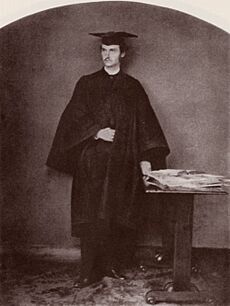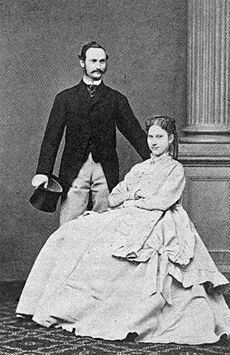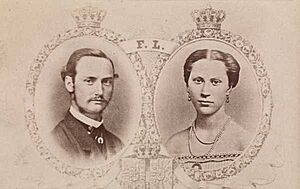Frederick VIII of Denmark facts for kids
Quick facts for kids Frederik VIII |
|||||
|---|---|---|---|---|---|
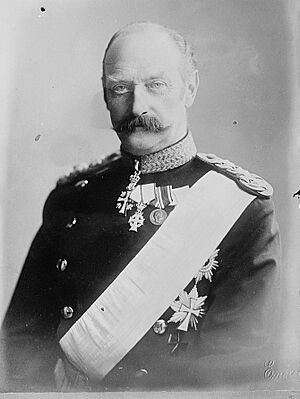
Frederik VIII in 1909
|
|||||
| King of Denmark (more...) | |||||
| Reign | 29 January 1906 – 14 May 1912 | ||||
| Predecessor | Christian IX | ||||
| Successor | Christian X | ||||
| Born | Prince Christian Frederik Vilhelm Carl of Schleswig-Holstein-Sonderburg-Glücksburg 3 June 1843 Yellow Palace, Copenhagen, Denmark |
||||
| Died | 14 May 1912 (aged 68) Hamburg, German Empire |
||||
| Burial | Roskilde Cathedral | ||||
| Spouse |
Louise of Sweden
(m. 1869) |
||||
| Issue Detail |
|
||||
|
|||||
| House | Glücksburg | ||||
| Father | Christian IX of Denmark | ||||
| Mother | Louise of Hesse-Kassel | ||||
| Religion | Church of Denmark | ||||
| Signature | |||||
Frederik VIII (Danish: Christian Frederik Vilhelm Carl; 3 June 1843 – 14 May 1912) was the King of Denmark from 1906 until his death in 1912.
He was the oldest son of King Christian IX, who was known as the Father-in-law of Europe because his children married into many royal families across Europe. This made Frederik related to many other royal families. Frederik was the heir apparent, meaning he was next in line to become king. He served as crown prince for over 42 years. During his father's long rule, Frederik did not have much power or influence in politics. When his father died in 1906, Frederik became king at 62 years old.
Frederik VIII was a king who supported new ideas. He was much more open to the new parliamentary system (where elected officials have more power) that started in 1901, unlike his father. He wanted to make reforms and believed in democratic ideas. However, because he became king late in life, his rule lasted only six years. He also had poor health during this time.
Frederik VIII married Louise of Sweden, and they had eight children. Their oldest son, Christian X of Denmark, became king after Frederik. Their second son, Carl, became King Haakon VII of Norway in 1905.
Early Life of Prince Frederik
Prince Frederik was born on June 3, 1843, at the Yellow Palace in Copenhagen, Denmark. This palace was an old house right next to the Amalienborg Palace, where the Danish royal family lived. He was the first child of Prince Christian of Schleswig-Holstein-Sonderburg-Glücksburg and Princess Louise of Hesse-Kassel. His father's family was a smaller branch of the Danish royal family, the House of Oldenburg.
Frederik was baptized on June 22 with the names Christian Frederik Vilhelm Carl. His family called him Fredy.
Frederik's Siblings and Family Life

Frederik had five younger brothers and sisters: Alexandra, William, Dagmar, Thyra, and Valdemar. Even though they were royal, their family lived a fairly normal life. They were not very rich. Their father's income from the army was about £800 a year, and their house was given to them for free. Sometimes, the famous storyteller Hans Christian Andersen would visit and tell the children bedtime stories.
In 1853, it became clear that the main line of the Oldenburg royal family would end because King Frederick VII was old and had no children. Frederik's mother, Louise, was very close to being next in line for the throne. Other relatives gave up their claims to the throne in favor of Louise. Then, Louise gave up her claim so that Frederik's father, Prince Christian, could be chosen as the heir. Because of this, Frederik became a Prince of Denmark.
Education and Royal Duties
On October 19, 1860, Frederik and his sister Princess Alexandra had their confirmation at Christiansborg Palace. After this, Prince Frederik received a lot of military training. He joined the Royal Danish Navy with his brother Valdemar. In 1863, Frederik went to study political science at the University of Oxford in England. But he returned to Denmark when his father became king in November of that year.
As the heir to the throne, Frederik was given a seat in the Danish Council of State, which is like a government council. He then helped his father with the duties of ruling the country. In 1864, he took part in the Second Schleswig War against Prussia and Austria.
The Crown Prince was also a member of the Danish Order of Freemasons. He was their leader, called the Grand Master, from 1871 until he died.
Marriage to Louise of Sweden
Queen Louise, Frederik's mother, wanted her oldest son to marry well, just like her two daughters, Alexandra and Dagmar, had. She hoped Frederik would marry one of Queen Victoria of the United Kingdom's daughters. Frederik was interested in Princess Helena, and she liked him too. However, Queen Victoria did not want her daughters to marry heirs to foreign thrones because it would mean they would have to live abroad. She preferred them to marry German princes who could live in England. Also, Queen Victoria was more supportive of Germany, and another alliance with Denmark (Frederik's sister Alexandra had married Victoria's son Edward) did not fit her plans.
After this, attention turned to Princess Louise of Sweden and Norway. She was the only daughter of King Charles XV of Sweden and Norway. Princess Louise belonged to the Bernadotte dynasty, which had ruled Sweden since 1818.
The marriage was suggested as a way to make Denmark and Sweden more friendly. The two countries had not been getting along well since Sweden did not help Denmark during the war with Prussia in 1864. Frederik and Louise had met in 1862. In 1868, Frederik was invited to Sweden to get to know Louise better, and their meeting went very well.
In July 1868, Crown Prince Frederik, who was 25, became engaged to 17-year-old Princess Louise. They were married a year later, on July 28, 1869, in the chapel at the Royal Palace in Stockholm. Louise was the first Swedish princess to marry into the Danish royal family since the Middle Ages. People in Denmark, Sweden, and Norway were happy about the marriage, seeing it as a symbol of friendship between the Scandinavian countries.
Family Life and Children
On August 10, 1869, the newly married couple arrived in Copenhagen and received a warm welcome. They were given Frederik VIII's Palace, an old palace that is part of the Amalienborg Palace complex in central Copenhagen, as their home. For their country home, they received Charlottenlund Palace, located about 10 kilometers north of Copenhagen by the Øresund Strait. This was a quiet place away from court life, and many of their children were born there.
Frederik and Louise had eight children: four sons and four daughters. They were born between 1870 and 1890. Their children were Prince Christian, Prince Carl, Princess Louise, Prince Harald, Princess Ingeborg, Princess Thyra, Prince Gustav, and Princess Dagmar. Their oldest sons, Christian and Carl, would later become kings of Denmark and Norway. Because they had so many children, Charlottenlund Palace was made bigger in 1880–81 with a dome and two extra parts.
Becoming King
Frederik was the crown prince for 43 years. He used this long time to prepare carefully for when he would become king. Even though he had a seat in the Council of State, his father, King Christian IX, mostly kept him from having much power or influence in politics.
Frederik's Reign as King
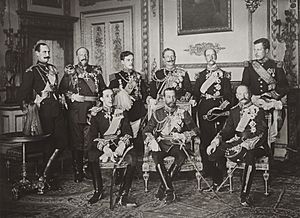
On January 29, 1906, King Christian IX died peacefully at 87 years old, after ruling for 43 years. When his father died, Frederik became king at 62. The Prime Minister, Jens Christian Christensen, announced him as King Frederik VIII from the balcony of Christian VII's Palace at Amalienborg.
Because he became king late in life, Frederik's rule lasted only six years. During this time, he often had health problems. Frederik VIII was a king who supported new ideas. He was much more open to the new parliamentary system than his father had been. He wanted to make reforms and believed in democratic ideas.
Death of Frederik VIII
On May 14, 1912, King Frederik was returning from a trip to Nice with his wife and four of his children. He stopped briefly in Hamburg, Germany, and stayed at the Hotel Hamburger Hof using the fake name "Count Kronberg". That evening, Frederik went for a walk by himself. He felt faint and collapsed on a park bench. A police officer found him and took him to the hospital, where he was declared dead. The cause of death was a heart attack. Because Frederik was using a fake name and had no identification, his body was taken to the local morgue. The hotel manager identified him the next morning.
Frederik's body was taken by a special train to Travemünde, and then brought back to Denmark on the royal yacht Dannebrog. After being honored at the chapel of Christiansborg Palace in Copenhagen, he was buried in Christian IX's Chapel in Roskilde Cathedral. This cathedral is the traditional burial place for Danish monarchs since the 1400s.
Frederik's Descendants
The current royal families of Denmark, Norway, Belgium, and Luxembourg are all related to King Frederik VIII. The Danish royal family comes from his oldest son, Christian X. The Norwegian royal family comes from his second son, Haakon VII, and also from his daughter, Princess Ingeborg of Denmark. The royal family of Belgium and the grand ducal family of Luxembourg are also related through Princess Ingeborg of Denmark.
Titles and Honours
Titles and Styles
During his time as king, Frederik's full title was: His Majesty Frederick VIII, By the Grace of God, King of Denmark, of the Wends and of the Goths, Duke of Schleswig, Holstein, Stormarn, Dithmarschen, Lauenburg and Oldenburg.
Awards and Recognitions
The Kronprins Frederiks Bro (Crown Prince Frederik's Bridge) in Frederikssund and King Frederick VIII Land in Greenland are named after him.
Awards from Denmark
- Knight of the Elephant, June 3, 1861
- Cross of Honour of the Order of the Dannebrog, June 3, 1861
- Grand Commander of the Dannebrog, July 28, 1869
- Commemorative Medal for the Golden Wedding of King Christian IX and Queen Louise, 1892
Awards from Other Countries
 Ascanian duchies: Grand Cross of the Order of Albert the Bear, April 4, 1863
Ascanian duchies: Grand Cross of the Order of Albert the Bear, April 4, 1863
 Austria-Hungary: Grand Cross of the Royal Hungarian Order of St. Stephen, 1873
Austria-Hungary: Grand Cross of the Royal Hungarian Order of St. Stephen, 1873 Baden:
Baden:
- Knight of the House Order of Fidelity, 1881
- Knight of the Order of Berthold the First, 1881
 Bavaria: Knight of St. Hubert, 1908
Bavaria: Knight of St. Hubert, 1908 Belgium: Grand Cordon of the Order of Leopold (military), May 23, 1866
Belgium: Grand Cordon of the Order of Leopold (military), May 23, 1866 Bulgaria:
Bulgaria:
- Knight of Saints Cyril and Methodius, with Collar
- Grand Cross of St. Alexander


 Ernestine duchies: Grand Cross of the Saxe-Ernestine House Order
Ernestine duchies: Grand Cross of the Saxe-Ernestine House Order France: Grand Cross of the Legion of Honour
France: Grand Cross of the Legion of Honour Greece: Grand Cross of the Redeemer
Greece: Grand Cross of the Redeemer Hawaii: Grand Cross of the Order of Kalākaua
Hawaii: Grand Cross of the Order of Kalākaua Hesse and by Rhine: Grand Cross of the Ludwig Order, May 5, 1865
Hesse and by Rhine: Grand Cross of the Ludwig Order, May 5, 1865 Italy: Knight of the Annunciation, May 10, 1875
Italy: Knight of the Annunciation, May 10, 1875 Japan: Grand Cordon of the Order of the Chrysanthemum, May 18, 1888
Japan: Grand Cordon of the Order of the Chrysanthemum, May 18, 1888 Mecklenburg: Grand Cross of the Wendish Crown, with Crown in Ore and in Diamonds, May 28, 1884
Mecklenburg: Grand Cross of the Wendish Crown, with Crown in Ore and in Diamonds, May 28, 1884 Nassau Ducal Family: Knight of the Gold Lion of Nassau
Nassau Ducal Family: Knight of the Gold Lion of Nassau Netherlands: Grand Cross of the Netherlands Lion
Netherlands: Grand Cross of the Netherlands Lion Oldenburg: Grand Cross of the Order of Duke Peter Friedrich Ludwig, with Golden Crown
Oldenburg: Grand Cross of the Order of Duke Peter Friedrich Ludwig, with Golden Crown Ottoman Empire: Order of Osmanieh, 1st Class in Diamonds
Ottoman Empire: Order of Osmanieh, 1st Class in Diamonds Portugal:
Portugal:
- Grand Cross of the Royal Military Order of Our Lord Jesus Christ
- Grand Cross of the Tower and Sword
- Grand Cross of Our Lady of Conception
- Grand Cross of the Sash of the Three Orders
 Prussia:
Prussia:
- Knight of the Black Eagle, December 8, 1866
- Grand Cross of the Red Eagle
 Romania:
Romania:
- Grand Cross of the Star of Romania
- Grand Cross of the Crown of Romania
 Russia:
Russia:
- Knight of St. Andrew, 1864
- Knight of St. Alexander Nevsky
- Knight of the White Eagle
- Knight of St. Anna, 1st Class
- Knight of St. Stanislaus, 1st Class
- Knight of St. Vladimir, 4th Class
 Saxe-Weimar-Eisenach: Grand Cross of the White Falcon, 1882
Saxe-Weimar-Eisenach: Grand Cross of the White Falcon, 1882 Siam:
Siam:
- Knight of the Order of the Royal House of Chakri, July 15, 1897
- Grand Cross of the White Elephant
 Spain: Knight of the Golden Fleece, April 19, 1883
Spain: Knight of the Golden Fleece, April 19, 1883
 Sweden-Norway:
Sweden-Norway:
- Grand Cross of St. Olav, with Collar, July 18, 1862
- Knight of the Seraphim, with Collar, August 7, 1862
- Knight of the Order of Charles XIII, November 4, 1871
- Commander Grand Cross of the Sword
 United Kingdom:
United Kingdom:
- Honorary Grand Cross of the Bath (civil), March 10, 1888
- Stranger Knight Companion of the Garter, July 21, 1896
- Honorary Grand Cross of the Royal Victorian Order, March 8, 1901
- Recipient of the Royal Victorian Chain, August 9, 1902
- Honorary Military Roles
- Colonel-in-Chief of The Buffs (Royal East Kent Regiment), 1906 – 1914 (United Kingdom)
- À la suite of the Imperial German Navy (a special honorary rank)
- Honorary General of the Swedish Army, 1891 (Sweden-Norway)
Frederik's Children
| Name | Birth | Death | Spouse | Children |
|---|---|---|---|---|
| Christian X of Denmark | 26 September 1870 | 20 April 1947 | Duchess Alexandrine of Mecklenburg-Schwerin | Frederik IX of Denmark Knud, Hereditary Prince of Denmark |
| Haakon VII of Norway | 3 August 1872 | 21 September 1957 | Princess Maud of Wales | Olav V of Norway |
| Princess Louise of Denmark | 17 February 1875 | 4 April 1906 | Prince Frederick of Schaumburg-Lippe | Marie Louise, Princess Friedrich Sigismund of Prussia Prince Christian of Schaumburg-Lippe Stephanie, Princess of Bentheim and Steinfurt |
| Prince Harald of Denmark | 8 October 1876 | 30 March 1949 | Princess Helena Adelaide of Schleswig-Holstein-Sonderburg-Glücksburg | Feodora, Princess Christian of Schaumburg-Lippe Caroline-Mathilde, Hereditary Princess of Denmark Alexandrine-Louise, Countess Luitpold of Castell-Castell Prince Gorm of Denmark Count Oluf of Rosenborg |
| Princess Ingeborg of Denmark | 2 August 1878 | 12 March 1958 | Prince Carl, Duke of Västergötland | Margaretha, Princess Axel of Denmark Märtha, Crown Princess of Norway Astrid, Queen of the Belgians Prince Carl Bernadotte |
| Princess Thyra of Denmark | 14 March 1880 | 2 November 1945 | unmarried | none |
| Prince Gustav of Denmark | 4 March 1887 | 5 October 1944 | ||
| Princess Dagmar of Denmark | 23 May 1890 | 11 October 1961 | Jørgen Castenskiold | Carl Castenskiold Christian Castenskiold Jørgen Castenskiold Dagmar Larsen Christian Frederik Castenskiold |
See also
 In Spanish: Federico VIII de Dinamarca para niños
In Spanish: Federico VIII de Dinamarca para niños



